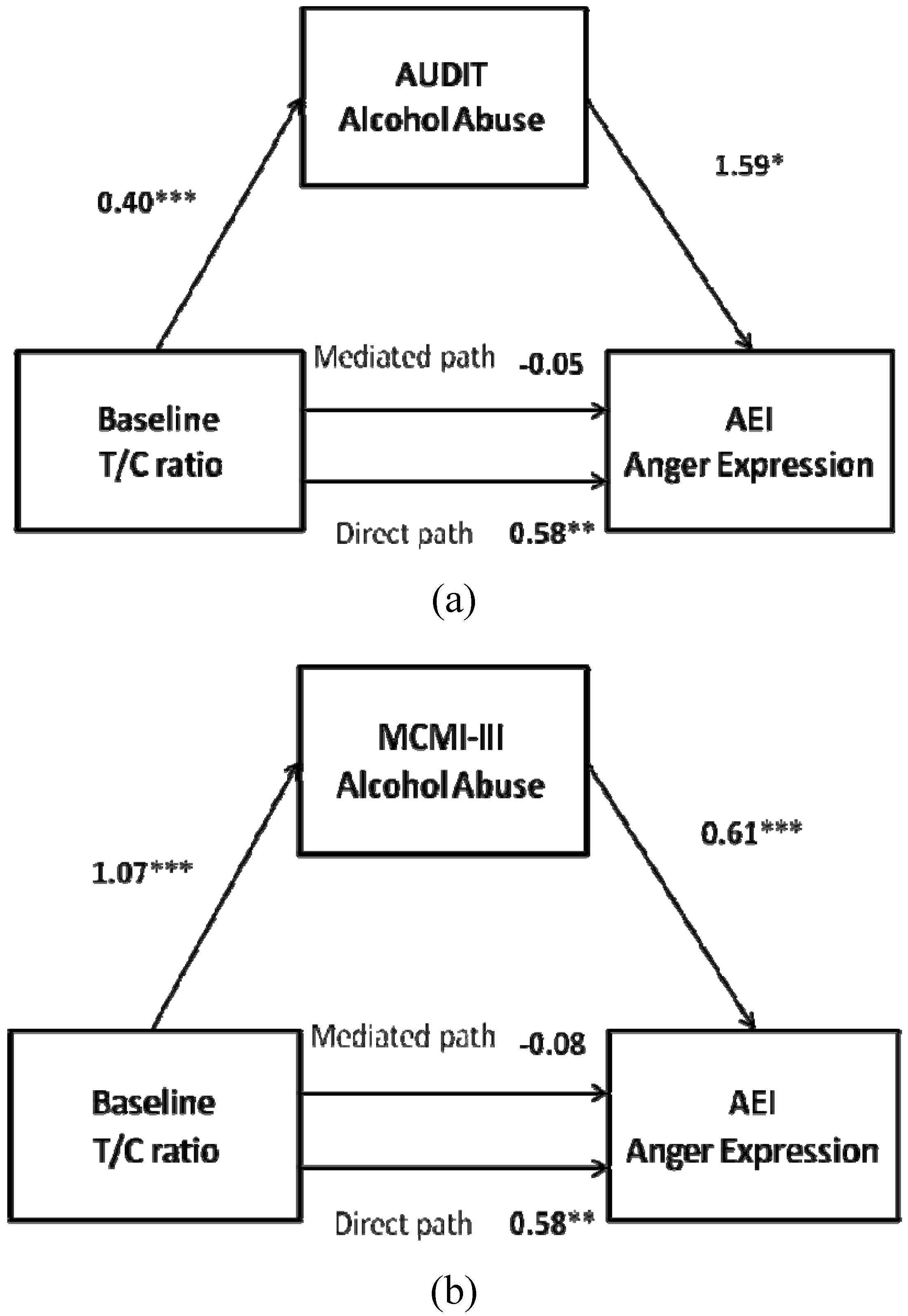Alcohol Abuse Mediates the Association between Baseline T/C Ratio and Anger Expression in Intimate Partner Violence Perpetrators
Abstract
:1. Introduction
2. Method
2.1. Participants
2.2. Procedure
2.3. Anger Expression
2.4. Alcohol Abuse
2.5. Hormone Measurements
2.6. Data Analysis
3. Results
3.1. Sample Characteristics, T/C Ratio and Anger

4. Discussion
5. Conclusions
Acknowledgments
Conflicts of Interest
References
- Terburg, D.; Morgan, B.; van Honk, J. The testosterone-cortisol ratio: A hormonal marker for proneness to social aggression. Int. J. Law Psychiatry 2009, 32, 216–223. [Google Scholar]
- Bergman, B.; Brismar, B. Hormone levels and personality traits in abusive and suicidal male alcoholics. Alcohol. Clin. Exp. Res. 1994, 18, 311–316. [Google Scholar] [CrossRef] [PubMed]
- Romero-Martínez, A.; González-Bono, E.; Lila, M.; Moya-Albiol, L. Testosterone/cortisol ratio in response to acute stress: A possible marker of risk for marital violence. Soc. Neurosci. 2013, 8, 240–247. [Google Scholar] [CrossRef] [PubMed]
- Lindman, R.; Järvinen, P.; Vidjeskog, J. Verbal interactions of aggressively and nonaggressively predisposed males in a drinking situation. Aggress. Behav. 1987, 13, 187–196. [Google Scholar] [CrossRef]
- Sarkola, T.; Eriksson, C.J. Testosterone increases in men after a low dose of alcohol. Alcohol. Clin. Exp. Res. 2003, 27, 682–685. [Google Scholar] [CrossRef] [PubMed]
- Hasselblatt, M.; Krieg-Hartig, C.; Hüfner, M.; Halaris, A.; Ehrenreich, H. Persistent disturbance of the hypothalamic-pituitary-gonadal axis in abstinent alcoholic men. Alcohol Alcohol. 2003, 38, 239–242. [Google Scholar] [CrossRef] [PubMed]
- Winslow, J.T.; Ellingboe, J.; Miczek, K.A. Effects of alcohol on aggressive behavior in squirrel monkeys: Influence of testosterone and social context. Psychopharmacology 1988, 95, 356–363. [Google Scholar] [PubMed]
- Lindman, R.E.; Aromäki, A.S.; Eriksson, C.J. Sober-state cortisol as a predictor of drunken violence. Alcohol Alcohol. 1997, 32, 621–626. [Google Scholar] [CrossRef] [PubMed]
- Popma, A.; Vermeiren, R.; Geluk, C.A.M.L.; Rinne, T.; van den Brink, W.; Knol, D.L.; Jansen, L.M.C.; van Engeland, H.; Doreleijers, T.A.H. Cortisol moderates the relationship between testosterone and aggression in delinquent male adolescents. Biol. Psychiatry 2007, 61, 405–411. [Google Scholar] [CrossRef] [PubMed]
- Shoal, G.D.; Giancola, P.R.; Kirillova, G.P. Salivary cortisol, personality, and aggressive behavior in adolescent boys: A 5-year longitudinal study. J. Am. Acad. Child Adolesc. Psychiatry 2003, 42, 1101–1107. [Google Scholar] [CrossRef] [PubMed]
- Etelälahti, T.J.; Saarikoski, S.T.; Eriksson, C.J. Associations of corticosterone and testosterone with alcohol drinking in F2 populations derived from AA and ANA rat lines. Alcohol Alcohol 2011, 45, 421–426. [Google Scholar] [CrossRef]
- Pinto, L.A.; Sullivan, E.L.; Ronsebaum, A.; Wyngarden, N.; Umhau, J.C.; Miller, M.W.; Taft, C.T. Biological correlates of intimate partner violence perpetration. Aggress. Violent Behav. 2010, 15, 387–398. [Google Scholar] [CrossRef] [PubMed]
- Lila, M.; Oliver, A.; Galiana, L.; Gracia, E. Predicting success indicators of an intervention programme for convicted intimate-partner violence offenders: The Contexto Programme. Eur. J. Psychol. Appl. Leg. Context 2013, 5, 73–95. [Google Scholar]
- Romero-Martínez, A.; Lila, M.; Sariñana-González, P.; González-Bono, E.; Moya-Albiol, L. High testosterone levels and sensitivity to acute stress in perpetrators of domestic violence with low cognitive flexibility and impairments in their emotional decoding process: A preliminary study. Aggress. Behav. 2013, 39, 355–369. [Google Scholar] [CrossRef] [PubMed]
- Miguel-Tobal, J.J.; Casado, M.; Cano-Vindel, A.; Spielberger, C.D. Adaptación española del Inventario de Expresión de Ira Estado-Rasgo STAXI-II; Tea Ediciones: Madrid, Spain, 2001. (In Spanish) [Google Scholar]
- Spielberger, C.D. Manual for the State-Trait Anger Expression Inventory-2; Psychological Assessment Resources: Odessa, FL, USA, 1999. [Google Scholar]
- Contell-Guillamón, C.; Gual-Solé, A.; Colom-Farran, J. Test para la identificación de trastornos por uso de alcohol (AUDIT): Traducción y validación del AUDIT al catalán y castellano. Adicciones 1999, 11, 337–347. [Google Scholar]
- Babor, T.E.; Grant, M.G. From clinical research to secondary prevention: International collaboration in the development of the Alcohol Use Disorders Identification Test (AUDIT). Alcohol Health Res. World 1989, 13, 371–374. [Google Scholar]
- Millon, T. MCMI-III Manual; National Computer Systems, Inc.: Minneapolis, MN, USA, 1994. [Google Scholar]
- Preacher, K.J.; Hayes, A.F. SPSS and SAS procedures for estimating indirect effects in simple mediation models. Behav. Res. Methods Instrum. Comput. 2004, 36, 717–731. [Google Scholar] [CrossRef] [PubMed]
- Catalá-Miñana, A.; Lila, M.; Oliver, A. Consumo de alcohol en hombres penados por violencia contra la pareja: Factores individuales y contextuales. Adicciones 2013, 25, 19–28. [Google Scholar] [PubMed]
- Romero-Martínez, Á.; Lila, M.; Catalá-Miñana, A.; Williams, R.K.; Moya-Albiol, L. The contribution of childhood parental rejection and early androgenexposure to impairments in socio-cognitive skills in intimate partner violenceperpetrators with high alcohol consumption. Int. J. Environ. Res. Public Health 2013, 10, 3753–3770. [Google Scholar] [CrossRef] [PubMed]
- Romero-Martínez, A.; Moya-Albiol, L. Neuropsychology of perpetrators of domestic violence: The role of traumatic brain injury and alcohol abuse and/or dependence. Revista de Neurología 2013, 57, 515–522. [Google Scholar] [PubMed]
© 2015 by the authors; licensee MDPI, Basel, Switzerland. This article is an open access article distributed under the terms and conditions of the Creative Commons Attribution license (http://creativecommons.org/licenses/by/4.0/).
Share and Cite
Romero-Martínez, Á.; Lila, M.; Moya-Albiol, L. Alcohol Abuse Mediates the Association between Baseline T/C Ratio and Anger Expression in Intimate Partner Violence Perpetrators. Behav. Sci. 2015, 5, 113-120. https://doi.org/10.3390/bs5010113
Romero-Martínez Á, Lila M, Moya-Albiol L. Alcohol Abuse Mediates the Association between Baseline T/C Ratio and Anger Expression in Intimate Partner Violence Perpetrators. Behavioral Sciences. 2015; 5(1):113-120. https://doi.org/10.3390/bs5010113
Chicago/Turabian StyleRomero-Martínez, Ángel, Marisol Lila, and Luis Moya-Albiol. 2015. "Alcohol Abuse Mediates the Association between Baseline T/C Ratio and Anger Expression in Intimate Partner Violence Perpetrators" Behavioral Sciences 5, no. 1: 113-120. https://doi.org/10.3390/bs5010113





